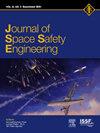Determining the accuracy and repeatability of the solid propellant motor burning rate extraction methods using laboratory static tests in two scales to increase the safety of motor operation
IF 1.7
Q3 ENGINEERING, AEROSPACE
引用次数: 0
Abstract
In the solid propellant motor, it is vital to specify the maximum burning rate of the propellant and consequently, the motor’s maximum pressure to increase safety in the operation of spacecraft and space thrusters. The burning time extraction method is the most effective parameter in determining the burning rate. The Quality statistical methods for comparing the burning time extraction methods were used because the burning rate was not known before the test. In this research, after selecting the widely used methods in the world's aerospace industries and preparing the software code by performing 26 small-scale static tests, the repeatability of the methods has been extracted, and then in the next step, for the first time, an innovative method to determine the accuracy of burning rate extraction methods was implemented. By designing the motor on a larger scale and performing 10 static tests, Vieille's law coefficient and power were extracted and given as input to a motor gas-dynamics simulation code. Due to the existence of static tests, it is possible to consider the accuracy of the methods in measuring the burning time and, consequently, the average pressure. The statistical results of the smaller motor show that the iterative burning time methods have similar behaviour and the Hessler-Glick and mass balance methods have the lowest coefficient of variation similar to the results of other references. Meanwhile, the reproducibility of the tangential method that is still used is very low. In the investigation of the accuracy in the static tests with different pressures in the larger scale motor, it has been determined that the most repeatable method is not necessarily the most accurate. Also, a difference of about 5 % in Vieille's law coefficient as the input gas-dynamics code parameters can increase the average calculated pressure error from 1 % to 10 %.
用两个尺度的实验室静态试验确定固体推进剂发动机燃速提取方法的准确性和可重复性,以提高发动机运行的安全性
在固体推进剂发动机中,确定推进剂的最大燃烧速率,从而确定发动机的最大压力,对提高航天器和空间推进器运行的安全性至关重要。燃烧时间提取法是测定燃烧速率最有效的参数。由于在试验前不知道燃烧速率,因此使用质量统计方法来比较燃烧时间提取方法。在本研究中,选取了世界航空航天工业中广泛使用的方法,并通过26次小规模静态试验编制了软件代码,提取了方法的可重复性,然后在下一步中,首次实现了确定燃烧速率提取方法准确性的创新方法。通过对电机进行大规模设计和10次静态试验,提取了Vieille定律系数和功率,并将其作为输入输入到电机气体动力学仿真代码中。由于存在静态试验,因此可以考虑测量燃烧时间和平均压力的方法的准确性。较小电机的统计结果表明,迭代燃烧时间法具有相似的行为,Hessler-Glick法和质量平衡法的变异系数最低,与其他参考文献的结果相似。同时,目前仍在使用的切向法的重现性很低。在对大型电机不同压力静态试验精度的研究中,已经确定重复性最高的方法不一定是最准确的。此外,输入气体动力学代码参数的Vieille’s law系数相差约5%,可使平均计算压力误差从1%增加到10%。
本文章由计算机程序翻译,如有差异,请以英文原文为准。
求助全文
约1分钟内获得全文
求助全文
来源期刊

Journal of Space Safety Engineering
Engineering-Safety, Risk, Reliability and Quality
CiteScore
2.50
自引率
0.00%
发文量
80
 求助内容:
求助内容: 应助结果提醒方式:
应助结果提醒方式:


